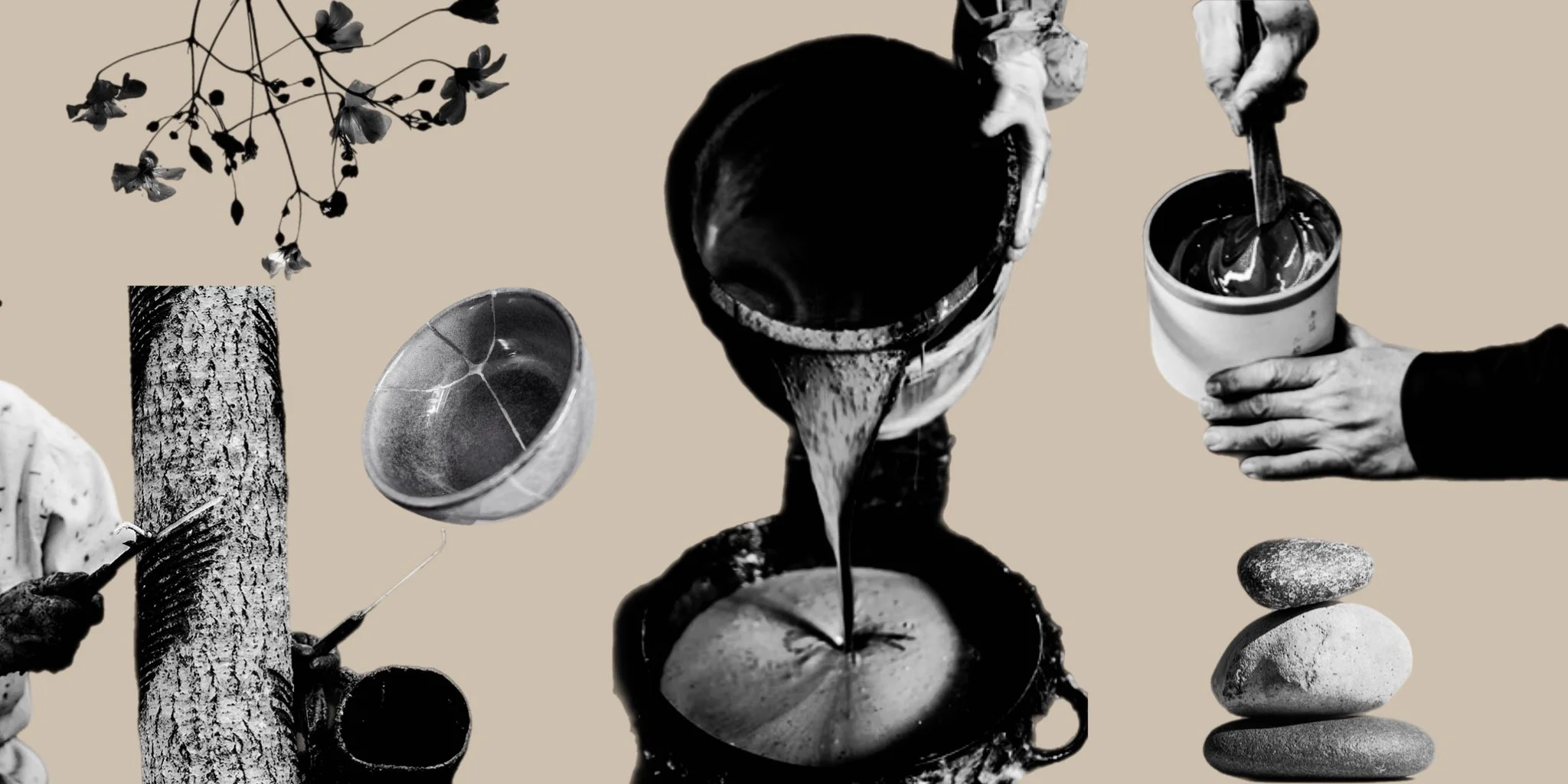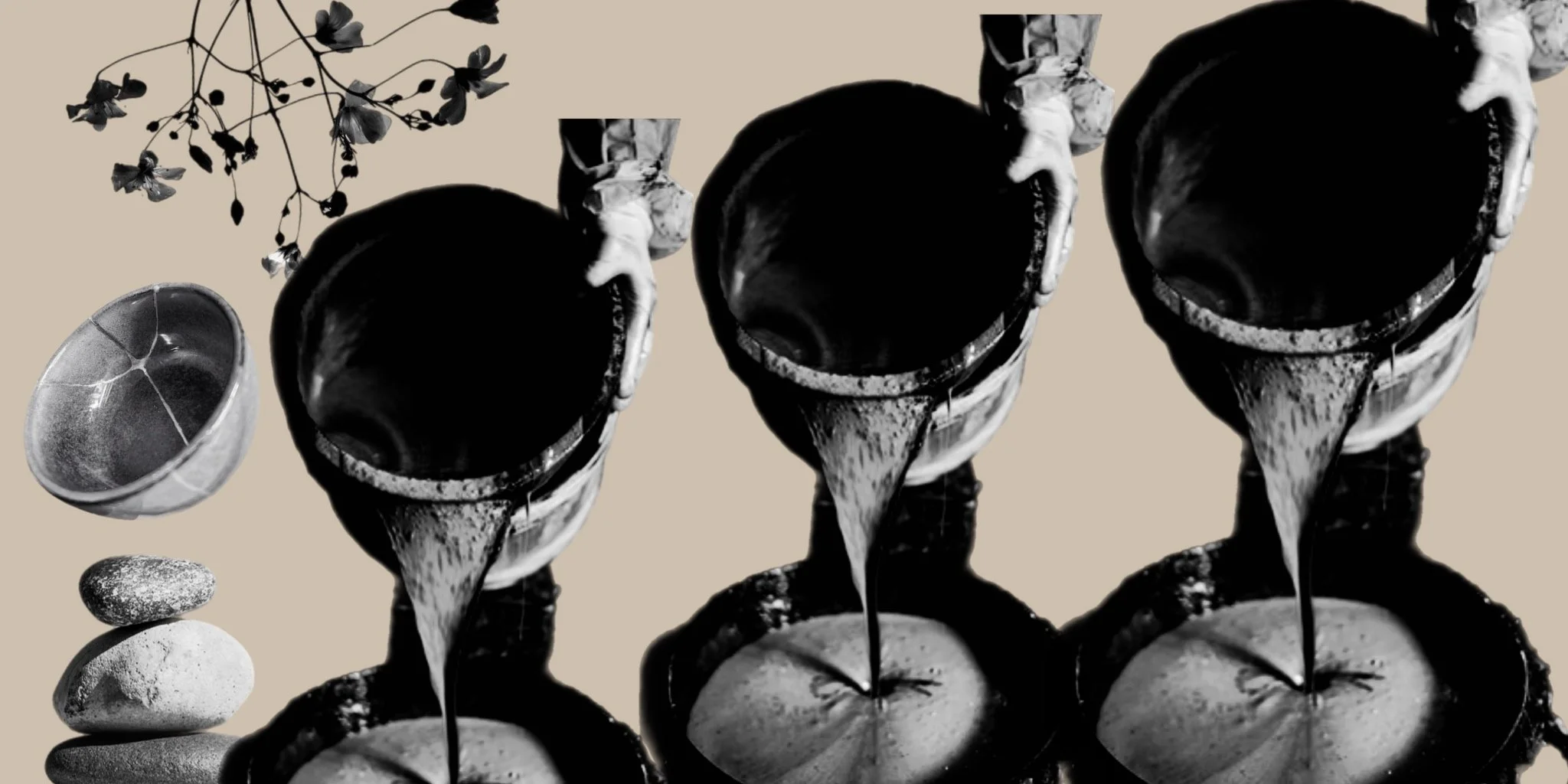Urushi Lacquer
The grand diva of historic craft materials
If you have attended our beginners modern-hybrid kintsugi repair workshop, you will have heard me ramble on about urushi lacquer. A mysterious and in some ways unpredictable material, with a storied history behind it, urushi is the keystone material behind long-form traditional kintsugi repair practice. And while in our beginners sessions we don’t work directly with urushi, we always prioritise educating you about it. Because as things move on, and new materials get folded into kintsugi repair to create different modern and modern-hybrid versions, this material is the absolute essence of kintsugi repair and wabi-sabi as an underlying philosophy.
So let’s give her the attention she deserves.
I often call urushi a ‘diva’ material, and I think this description fits perfectly. Because just like Cher, Madonna or Mariah, this material was sent to us by a higher power to be revered. We put up with her shortcomings not just begrudgingly, but happily. Her behaviour might be wildly erratic, but when she sings, she REALLY sings.
Behind every beautiful urushi finish, there is a story of trial and error. failure and tenacity. Just like a diva, urushi bounces back (she is thermoplastic, after all). So what is the deal with this gorgeous and complicated resinous material?
WHAT IS URUSHI?
Well, to get into the weeds… Urushi lacquer, derived from the sap of the Toxicodendron vernicifluum tree native to East Asia, is a traditional, highly valued natural resin used for centuries in Japanese, Chinese, and Korean decorative arts. The sap contains urushiol, a compound that hardens into a durable, waterproof, and glossy coating when exposed to humidity and warm temperatures. This curing process, known as polymerization, gives urushi its exceptional strength, resistance to heat, water, acid, and alkali, and its distinctive deep luster that improves with age.
Harvesting urushi is a meticulous and time-consuming process: the lacquer trees must mature for 10 to 15 years before they can be tapped, and even then, each tree yields only about 200 milliliters of sap per year. Tappers make small incisions in the bark during the summer months and collect the sap slowly over several weeks. Because of this limited yield, the long maturation period of the trees, and the labor-intensive refining and application process, high-quality urushi is considered a rare and increasingly scarce resource. Sustainable harvesting practices are crucial, as over-tapping or poor management can damage the tree or reduce future yields, contributing further to its scarcity.
AFTER HARVESTING
Once harvested, raw urushi sap—known as arami urushi—undergoes a meticulous refining process before it can be used. The sap is first filtered to remove impurities such as bark, dust, and moisture. It is then gently stirred and sometimes heated to adjust its viscosity and remove excess water, resulting in different grades of lacquer suited for various purposes (e.g., base coats, top coats, or decorative layers). The lacquer is highly sensitive to its environment and requires specific curing conditions: it hardens not through evaporation, but by polymerizing in a warm, humid space—traditionally, a furo or muro (curing chamber) maintained at around 20–25°C with 75–85% humidity. The application process involves building up multiple thin layers, with each layer carefully brushed on, allowed to cure, and then polished using charcoal or fine abrasives to achieve a smooth surface. This process can be repeated dozens of times depending on the desired finish and durability. Urushi can be applied to a variety of surfaces, most commonly wood, ceramics, metal, leather, and even fabric, making it a versatile and time-tested material for both functional and ornamental objects. The result is a resilient, gleaming finish that can last centuries if properly maintained.
The use of urushi in the finishing and repair of objects is a long and storied one. From the coating of furniture and tableware, to the varishing of instruments. Urushi harvesting and use is centuries old, and serves so many purposes in Asian culture. Interestingly, there seem to be sister versions of urushi which can be found across the world. Mopa Mopa, for example, which is found in South America, is derived from the buds of the Elaeagia pastoensis tree in the Andean region. This resin can be heated and stretched, and is equal to urushi in its labour-intensive nature, and level of skill required to harvest it.
So, what are some of the properities that make urushi such a diva? Well, aside from insisting on a specific range of temperature and humidity in her dressing room (or in this case, her muro), there are some qualities that describe both urushi’s unparalelled beauty, and complicated nature.
ANATOMY OF A DIVA MATERIAL
EXCEPTIONAL DURABILITY
Although urushi takes a long time to cure - 5-7 days on average depending on the conditions - once cured, urushi is extremely durable. And unlike many modern materials, stands the test of time in terms of strength. In fact, it has been established in some recent studies urushi can actually gain in strength over time. Urushi is highly resistant to scratches, abrasions, and wear. This makes it ideal for both decorative and functional items like tableware, furniture, and tools. In the case of kintsugi repair, when a finish is coated in glass-specific urushi, you will find that as the curing process progresses over months and years, if properly applied, you can have a repair that will withstand centuries.
WATERPROOF AND CHEMICAL RESISTANT
And she’s waterproof! This is what makes urushi the ideal companion to your food-grade safe repair practice. One of the most asked questions I get in the studio is whether or not modern kintsugi repairs are food safe. Many people would love to spend only a couple of hours on a Saturday afternoon sticking a plate back together, and be able to safely incorporate it back into thier kitchen as a working object. The problem with this is that modern materials are just not in a place where food safety can be promised (and be very sceptical of any product that promises this). While you might get a water-tight repair using modern materials, you will struggle to find any that are completely food safe. However, urushi lacquer is not only food-grade safe when cured, but it’s also waterproof, chemical resistant AND antibacterial! So yes, Barbara. You will need to spend a little extra time and effort to achieve a gorgeous kintsugi repair, but you can love that object for generations afterward. Imagine your grand daughter serving canapés off of your very own repaired plate. Priceless.
GLOSS AND DEPTH
Want more glow than Beyoncé on night one of the Cowboy Carter tour? Nothing beats the radiance of a pampered, well-rested diva—except, perhaps, a freshly cured line of urushi lacquer. Gleaming with anticipation, just waiting for its final polish. When this step is nailed, the result is almost untouchable: a surface so rich and radiant, it seems to hold light within it. Urushi’s signature gloss isn’t just surface-level shine—it’s a deep, dimensional luster that evolves as the lacquer ages and cures. With each ultra-thin layer applied, cured, and hand-polished, the finish builds toward a depth that feels alive. Its unique optical quality, akin to fine enamel or centuries-old varnish, not only enhances the grain of wood or texture of ceramic, but also brings out the finest details in any decorative design. There’s a reason urushi has been revered for over 7,000 years. When handled masterfully, it doesn’t just shine—it radiates.
THERMOPLASTIC FLEXIBILITY
Like any good diva, you will also find urushi to be sensitive underneath her tough exterior. Thermoplasticity, in a nutshell, is the propensity of a material’s molecules to remain supple and flexible under certain environmental conditions. In other words, instead of snapping, she bends. This characteristic contributes to urushi’s longevity and resistance to aging. Although urushi is a natural material that hardens through enzymatic oxidation and humidity rather than heat (we’re talkin polymerisation here, people), once cured, it retains a subtle flexibility. This elasticity allows the lacquer to expand and contract with changes in temperature and humidity without cracking or detaching from the surface beneath it. Unlike brittle synthetic finishes, urushi can absorb minor stresses and movement, which is especially important for objects made from wood, a naturally dynamic material. In kintsugi repair, this serves as added protection for your traditional repairs, affording them an extra insurance against damage.
NATURAL AND BIODEGRADABLE
To top it all off, she’s all natural, baby. Harvested, purified, refined. By the time it reaches your gloved hands, every drop of urushi has been coddled to provide you with the most incredible natural bonding and finishing material. When choosing materials it is always important to take into account what the end result will be. From a sustainability perspective, some things to consider include what the object will be used for after the repair, and where your materials are sourced from. In some cases, ordering materials from across the world carries its own footprint. You will often find that as you work through a traditional long-form kintsugi repair that you are left with very few wasted materials. It takes such small quantities to create a beautiful repair. Overall, the benefits of using a natural resin like urushi far outweighs the cons in the end.
We are finally offering a comprehensive introduction to the use of urushi lacquer within our Intermediate Kintsugi Repair sessions. You will have the opportunity to expand your repair practice, while learning to competently handle this complex material in the studio and at home. Very limited spaces available over the year, so make sure you sign up to our newsletter and book ahead.
Love,
T.S.C.






